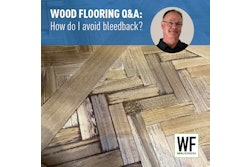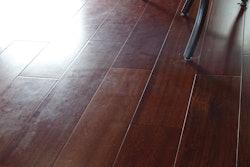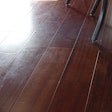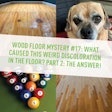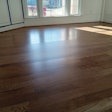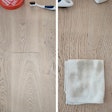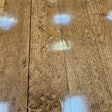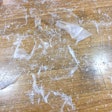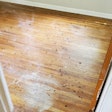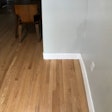The Problem
I received a call from an extremely frustrated contractor in the Pacific Northwest who was panicked because some areas of a floor he had coated with waterborne finish had taken on a grayish cast, and the finish was soft. He thought he had done everything by the book. He was already backed up on his jobs, and now he had to figure out what had gone wrong with this floor and how to fix it.
The Procedure
The contractor installed 2,000 square feet of red oak strip flooring over a plywood subfloor in various rooms of an upscale home. He carefully checked the moisture content of the flooring upon delivery and made sure that the moisture content of the subfloor and strip flooring were within 4 percentage points of each other before installation. After sanding, he came back the next day to apply the first sealer coat. He returned three hours later to apply another sealer coat. The next day, he abraded the floor with a pad and strip system, then applied the topcoat. During the application of each finish coat, he turned off the HVAC system, turning it back on a half hour after he was done with a coat, as recommended by the finish manufacturer. When hecame back the following day to pull tape from the transition areas and check the floor, he noticed that in some areas, the finish appeared gray and wasn't as hard as it should have been.
The Cause
The contractor followed the waterborne finish manufacturer's recommended dry times between each coat, not taking into consideration that this is a general guideline and that times can vary depending on the environmental conditions. Ithad been steadily raining during the week when the contractor was doing this job, and althoughthe HVAC system was running, the humidity levels in the house were probably too elevated,hampering drying of the finish. When waterborne finish doesn't dry enough between coats, it may appear gray, like this floor, or it may appear clear but "greasy." It also can remain soft instead of hardening as usual. Areas of the floor with the least amount of air circulation tend to have the most problems. In this case, areas closer to HVAC vents tended to be dry, while other areas and rooms with less air movement had the grayish, soft finish.
How to Fix the Floor
Before doing anything to fix the floor, it was important to start with baseline moisture readings from different spots throughout the floor. Then, the finish manufacturer recommended that the contractor cut the floor aggressively with an 80- to 100-grit screen to open up the film, letting the trapped solvents escape. Once the floor was abraded, he circulated air over the floor and out of the house. Every two to three days, he tacked the floor with an approved hardwood floor cleaner to remove the solvent, and he took moisture readings every one to two days to determine when it was safe to recoat the floor. In this case,after eight days, the floor had returned to its original moisture readings before it was coated. At that point, the floor was ready for coating again.
In the Future
It is highly recommended that contractors test the moisture content of the floor between waterborne finish coats to ensure that the finish is dry enough for another coat. The moisture content readings ofthe dry finish coat should be at the original moisture content readings of the bare wood floor (check with the finish manufacturer—some say the floor should be within one percentage point). To test the moisture content, use a moisture meter recommended by the finish manufacturer.
Also, remember that a wood flooring job site is supposed to be at "normal living conditions" at all times, typically with a relative humidity level between 30 and 50 percent. A simple hygrometer is inexpensive and measures the relative humidity. A humidity level that is outside the parameters of these conditions is a good warning that the finish may need longer dry times.
Remember, an ounce of prevention is better than a pound of cure, and moisture is the No. 1 enemy of wood floors. In addition to taking moisture readings of the subfloor and wood flooring and acclimating the flooring before installation, also take moisture readings prior to the first coatof waterborne finish and before each subsequent coat. Recording these moisture levels during each step of the job is a sign of professionalism. It can help you troubleshoot a job if something goes wrong, and also can help defend you in case you're faced with liability. Most importantly, it helps you do everything right the first time.















